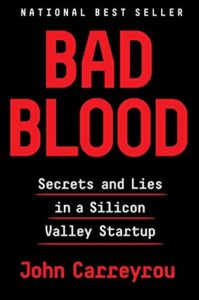 Yes, that was my week, last week. Bad stories, Bad blood. Bad, bad, bad. In fact, it was so bad, it was great!!!! Bear with me.
Yes, that was my week, last week. Bad stories, Bad blood. Bad, bad, bad. In fact, it was so bad, it was great!!!! Bear with me.
First, I got an email invitation from the Cream Literary Alliance, a writers’ group in Palm Beach. It was for a three-hour workshop. It contained that magic word, “obsession.” I love that word. I especially love it when it’s the driving force in a novel. (Obsessive love –is there any other kind?– was the antagonist’s motive in my first novel, Scandal.) Last week’s invitation promised that Steve Almond would teach a craft class on How To Turn Your Obsessions into Irresistible Prose.
Steve Almond? Who he?
The invitation described him as a “prolific and important contemporary writer.” I hadn’t heard of him so, of course, I googled him. I discovered he’s an author, former newspaper reporter, a podcaster and creative writing teacher. I also tuned into his YouTube presentation of a similar craft class: “Obsession is at the center of most books that survive (Think, Moby Dick)” says Almond, adding, “Obsessions are the purest form of our consciousness; it’s where our dark knowledge of ourselves collides with our Facebook version of ourselves.”
Yes, please. Sign me up!
 Then, I googled Steve’s published works, and found Bad Stories: What The Hell Just Happened To Our Country? I clicked on the “Look Inside” feature, read the first couple of chapters, and decided I was going to really enjoy this book. So, I purchased the book, downloaded it — and devoured it over the next six hours or so.
Then, I googled Steve’s published works, and found Bad Stories: What The Hell Just Happened To Our Country? I clicked on the “Look Inside” feature, read the first couple of chapters, and decided I was going to really enjoy this book. So, I purchased the book, downloaded it — and devoured it over the next six hours or so.
At its simplest level, Bad Stories is Steve Almond’s analysis of how the oaf, otherwise known as Donald Trump, was able to move into the Oval Office. It’s an interesting treatise because in Almond’s analysis of factors that led to Trump’s election hardly anyone escapes unscathed. And, that leads him to a deeper examination of what’s gone wrong with “our great democratic experiment.”
By which I mean, Almond blames left-wing pundits, the Internet, the mainstream media and late night comedians as much as he blames Russian interference, talk radio propaganda (rising out of the rescinding of the Fairness Doctrine), — and the 104 million voters who did not vote in the 2016 election.
Almond looks at a number of bad stories — I would call them myths– that those non-voting voters told themselves as to why they didn’t have to vote because there was no way Trump would ever become president.
So Much Fun

For example, consider the following “bad stories” under chapter headings like this:
What Amuses Us Can’t Hurt Us: Almond writes that Les Moonves (then chairman and CEO of CBS-TV, now a disgraced sexual predator) characterized Trump’s campaign as a “circus.” Moonves described Trump’s run in February of 2016 as follows, “It may not be good for America , but it’s damn good for CBS […] Man, the money’s rolling in and this is fun.”
Steve Almond then observes: “The bad story that helped Moonves take such a jocular tone was that Trump couldn’t possibly win.”
Or, consider the chapter, Our Court Jesters Will Rescue the Kingdom. Here, Almond looks at Jon Stewart, the former host of The Daily Show as representative of those late-night comedians “who decanted the anguish and the rage of the left into laughs.”
Adds Almond: “Trump won the GOP nomination because his cartoonish view of an America in ruins, besieged by dark hordes, felt real to millions of voters. And, what was the left’s conditioned response?
“But fuck, this guy is so much fun.”
Feminine Complicity

Or, take, for example, this bad story: American Women Will Never Empower A Sexual Predator. This, of course, turned out to be a total myth considering some surveys subsequently concluded that 47 per cent of white women (only 6 per cent of black women) voted for Trump.
Almond writes: “What all these women had in common was a willingness to dismiss or tolerate his words and behaviors and attitudes toward other women. Trump didn’t just drag misogyny out of the shadows ; he cast it in neon , touting his endowment and his stamina , demonstrating his dominion over women . His private conduct was merely an extension of what we saw in public as he stalked Clinton or lashed out at uppity female anchors.
But Trumpism activated something more visceral : the hidden power of ingrained patriarchal thought (my highlight.)The most potent weapon in the Trump arsenal wasn’t virility, but feminine complicity.
Mass Delusion
In summary, Almond writes: ” Media outlets presented the race as a rank spectacle because we couldn’t resist the urge to hate watch. There was something pornographic in the arrangement, a familiar tension between grotesque fascination and shame.
“On election night, when it finally dawned on the anchors and viewers that Trump had won the Electoral College, you could sense the shock of a mass delusion being shattered in real time, That delusion amounted to a coup we had engineered against ourselves, arising from unseriousness and bad stories.” .
Con Artist
Finally, I enjoyed this observation where Almond seems to blame all of us for Trump’s election to president. He writes: “Trump embodied the duality at the heart of this nation’s cult of success. Objectively, he tanked everything he touched : casinos, airlines, marriages, football teams, fake universities.
“But he reacted to these flops by defiantly — almost poignantly — declaring victory . He became the con artist lurking within all of us, the Facebook self – promoter and resume padder writ large.”
Bad Blood
 That’s the title of a book by John Carreyrou, a Wall Street Journal reporter, about ultimate con artist, Elizabeth Holmes. She’s the founder of a Silicon Valley startup, Theranos, which she catapulted into the stratosphere where it was valued, at one point, at $9 BILLION dollars.
That’s the title of a book by John Carreyrou, a Wall Street Journal reporter, about ultimate con artist, Elizabeth Holmes. She’s the founder of a Silicon Valley startup, Theranos, which she catapulted into the stratosphere where it was valued, at one point, at $9 BILLION dollars.
Bad Blood, which traces the downfall of the company and its enigmatic founder (it’s now valued at zero dollars and Holmes has been indicted for fraud) has been on my TBR list for months. But when I read that an HBO documentary, The Inventor: Out for Blood in Silicon Valley covers the same ground and includes interviews with Carreyrou, I took the lazy way out and tuned into the 2-hour movie.
It’s a totally fascinating look at how the Stanford dropout lost $900 million of investor capital with her blood-testing startup. The documentary examines how Holmes deceived business leaders around the world with her claims that she was going to revolutionize the U.S. health care industry with her device (“the Edison”) which would test just one drop of blood for a whole array of diseases.

As it turned out, Holmes and her business partner fudged and faked results when investors came to tour her lab in Palo Alto. It became harder to fake results when she contracted with Walgreens to use her device on real-life patients. Doctors of those patients got suspicious when results for patients they had treated for years were wildly inconsistent with their histories.
The documentary is particularly fascinating for the videos of Holmes at company meetings, rallying the employees, embodying the Silicon Valley mantra, “fake it till you make it.” The documentary is worth watching just to see Holmes and her unblinking blue eyes, and hear her deep baritone voice — which are almost always the first things mentioned about her to explain how she managed to con multibillionaires out of money for her project.